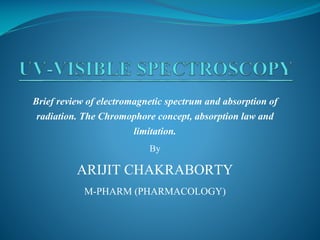
The theory of electromagnetic spectrum, absorption,
- 1. Brief review of electromagnetic spectrum and absorption of radiation. The Chromophore concept, absorption law and limitation. By ARIJIT CHAKRABORTY M-PHARM (PHARMACOLOGY)
- 3. Electromagnetic spectrum: The arrangement of all types of electromagnetic radiations in order of their increasing wavelengths or decreasing frequencies is known as complete electromagnetic spectrum. If we arrange all types of electromagnetic radiations in order of their increasing wavelengths, then the portion above the visible region is called Infra-red while that below it is the ultra-violet region.
- 5. In a electromagnetic spectrum, we may note that : i. Visible and ultra-violet radiation cover the wavelength range from 200-800 mµ. The absorption of radiation in this region causes the excitation of π electron in a conjugated or an unconjugated system. ii. The Infra-red radiations which cover the wavelength range from 0.8 to 2.5 µ constitute near Infra-red region and that from 15 to 25 µ is called far Infra-red region. The most useful region for Infra-red spectroscopy is 2.5 to 15 µ.
- 6. iii. NMR spectroscopy provides a complete insight into the environment and arrangement of atoms within a molecule. For this technique, radiation of longest wavelength range, i.e., Radio waves are useful. Due to the different environmental effects, different magnetic nuclei ( say protons, N15, C13, F19, P31 atoms etc.) will feel the applied magnetic field differently. Hence, absorptions at different field strengths will correspond to different sets of protons or magnetic nuclei.
- 8. Chromophore: It is define as isolated covalently bonded group that shows a characteristic absorption in the ultraviolet or the visible region. There are two types of chromophores: a. Chromophore in which the group contains electrons and they undergo n–›π* transition. Such chromophores are ethylene's, acetylenes etc. b. Chromophore which contain both π electrons and n (non-bonding) electrons. Such chromophores undergo two types of transition i.e., π–›π* and n–›π*.
- 9. There are some points: a. Spectrum consisting of a band near 300 mµ may contain two or three conjugated unites. b. Absorption bands near 300 mµ with very low intensity, €max 10-100 are due to n–›π* transitions of the carbonyl group. c. Simple conjugated chromophores such as dines have high €max values, i.e., from 10,000 to 20,000. d. The absorption with €max value between 1000 to 10,000 shows an aerometric system.
- 10. ABSORPTION LAW AND LIMITATION
- 11. Lambert’s Law: The intensity of the transmitted light passing through a homogeneous medium decreases geometrically as the thickness of the layer increases arithmetically. Beer’s Law: Each molecule of solute absorbs the same fraction of light incident upon it, regardless of concentration in a non-absorbing medium. Beer’s law does not hold over the entire concentration range, but in very dilute solutions, as in uv-spectroscopy, the deviations are small.
- 12. BEER’S LAW: LIMITATIONS The linearity of the Beer-Lambert law is limited by chemical and instrumental factors. Causes of nonlinearity include: 1. Deviations in absorptivity coefficients at high concentrations (>0.01M) due to electrostatic interactions between molecules in close proximity . 2. Scattering of light due to particulates in the sample.
- 13. 3. Changes in refractive index at high analyte concentration. 4. Shifts in chemical equilibrium as a function of concentration. 5. Non-monochromatic radiation, deviations can be minimized by using a relatively flat part of the absorption spectrum such as the maximum of an absorption band.
